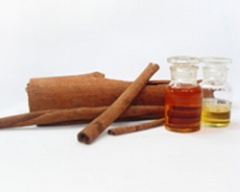Cinnamon Oil
| Infobox on Cinnamon Oil | |
|---|---|
| Example of Cinnamon Oil |  |
| Facts | |
| Origin | - |
| Density (in t/m3) | - |
| Temperature (in oC) | - |
| Humidity / moisture | - |
| Ventilation | - |
| Self-heating / spontaneous combustion | - |
| Risk factors | - |
Cinnamon Oil
Contents
Description
Derived by distillation from the leaves, bark or roots of the tree Cinnamomum Zeylanicum.
Its flavour is due to an aromatic essential oil which it contains to the extent of from 0.5 to 1%. This oil is prepared by roughly pounding the bark, macerating it in sea-water, and then quickly distilling the whole. It is of a golden-yellow colour, with the characteristic odour of cinnamon and a very hot aromatic taste. The pungent taste and scent come from cinnamic aldehyde or cinnamaldehyde and, by the absorption of oxygen as it ages, it darkens in colour and develops resinous compounds. Chemical components of the essential oil include eugenol, cinnamaldehyde, beta-caryophyllene, linalool and methyl chavicol.
Shipped in hermetically sealed drums or tins. Used in the manufacture of medicines and perfumery, also as a flavouring. Leakage from containers will damage edible goods.
See Cinnamon











